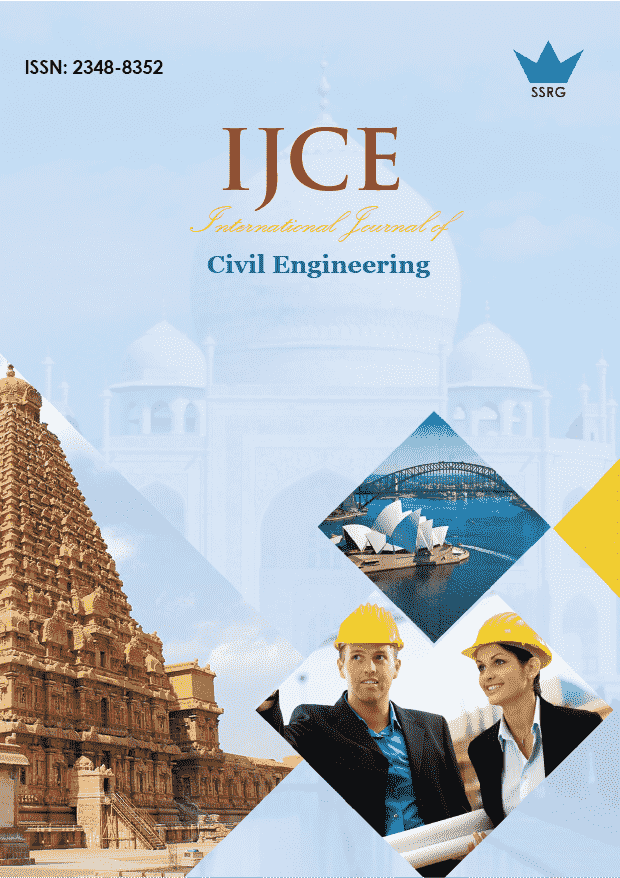Increasing the strength of existing building using steel jacketing in seismic zone

| International Journal of Civil Engineering |
| © 2017 by SSRG - IJCE Journal |
| Volume 4 Issue 12 |
| Year of Publication : 2017 |
| Authors : Mr. Vijay Singh Rawat |
How to Cite?
Mr. Vijay Singh Rawat, "Increasing the strength of existing building using steel jacketing in seismic zone," SSRG International Journal of Civil Engineering, vol. 4, no. 12, pp. 7-11, 2017. Crossref, https://doi.org/10.14445/23488352/IJCE-V4I12P102
Abstract:
This research project will give a brief presentation about earthquake resistant design and the methodology about seismic evaluation and rehabilitation of existing structures by steel jacketing. It also provides certain aspects of computer software modeling against seismic loads and shows the necessity of seismic upgrading in existing building. The seismic evaluation process consists of investigating if the structure meets the defined target structural performance levels. The main goal during earthquakes is to assure that building collapse doesn’t occur and the risk of death or injury to people is minimized and beyond that to satisfy post-earthquake performance level for defined range of seismic hazards. Also seismic evaluation will determine which are the most vulnerable and weak components and deficiencies of a building during an expected earthquake. The seismic rehabilitation process aims to improve seismic performance and correct the deficiencies by increasing strength, stiffness or deformation capacity and improving connections. Thus, a proposed retrofit implementation can be said to be successful if it results an increase in strength and ductility capacity of the structure which is greater than the demands imposed by earthquakes.
Keywords:
implementation can be said to be successful if it results an increase in strength and ductility capacity of the structure which is greater than the demands imposed by earthquakes.
References:
1) Berman, J and Bruneau, M (2003), „„Experimental investigation of light-gauge steel plate shear walls for the seismic retrofit of buildings.‟‟ Tech. Rep. MCEER-03-0001, Multidisciplinary Center for Earthquake Engineering Research, State University of New York at Buffalo, Buffalo.
2) N.Y. Berman, J and Bruneau, M (2004), “Steel plate shear walls are not plate girders”, AISC Engineering Journal, (in press).
3) Caccese, V, Elgaaly, M and Chen, R (1993), „„Experimental study of thin steel-plate shear walls under cyclic load.‟‟ Journal of. Structtural Engineering, 573–587.
4) Civjan, S A, Engelhardt, M D and Gross, J L (2001), “Slab effects in SMRF retrofit connection tests,” Journal of Structural Engineering, ASCE, Vol. 127, No. 3, pp 230-237.
5) Civjan, S J, Engelhardt, M D, and Gross, J L (2000), “Experimental program and proposed design method for the retrofit of steel moment connections,” Proceedings, 12th World Conference on Earthquake Engineering, Auckland, New Zealand.
6) Civjan, S, Engelhardt, M D and Gross, J L (2000), “Retrofit of pre-Northridge moment resisting connections,” Journal of Structural Engineering, ASCE, Vol. 126, No. 1, pp. 69-78.
7) Christopoulos, C, Filiatrault, A and Uang, C M (2002a), “Self-centering post-tensioned energy dissipating (PTED) steel frames for seismic regions,” Structural Systems Research Project Report No. SSRP-2002/06, Department of Structural Engineering, University of California, San Diego, La Jolla, CA, 292 p.
8) Christopoulos, C, Filiatrault, A, Folz, B and Uang, C M (2002b), “Post-tensioned energy dissipating connections for moment-resisting steel frames,” ASCE Journal of Structural Engineering, 128(9): 11111120.
9) Collins, J H and Filiatrault, A (2004), “Application of post-tensioned energy dissipating (PTED) connections in steel moment-resisting frames,” Report No. SSRP-2003/05, Department of Structural Engineering, University of California, San Diego.
10) Dowdell, D and Hamersley, B (2001), “Lions‟ Gate Bridge North Approach: seismic retrofit”, behaviour steel structures in seismic areas”, Proceedings of the Third International Conference: STESSA 2000; Montreal, Canada, August 21-24, 2000, pp.319-326.

 10.14445/23488352/IJCE-V4I12P102
10.14445/23488352/IJCE-V4I12P102